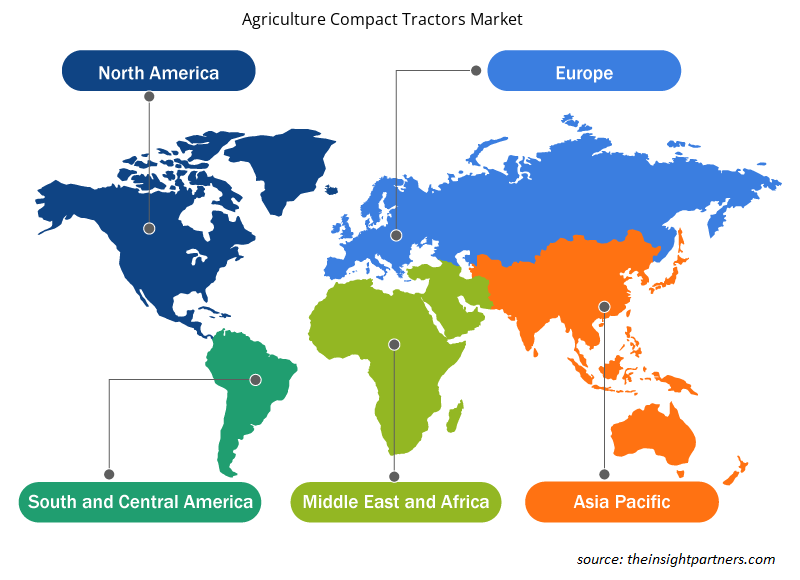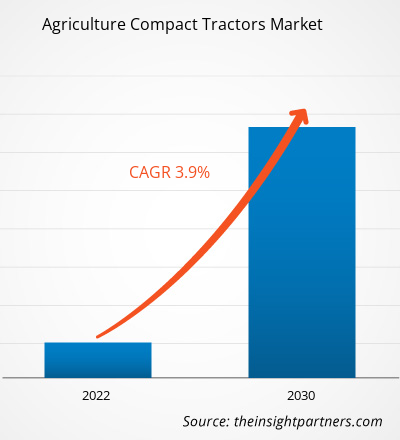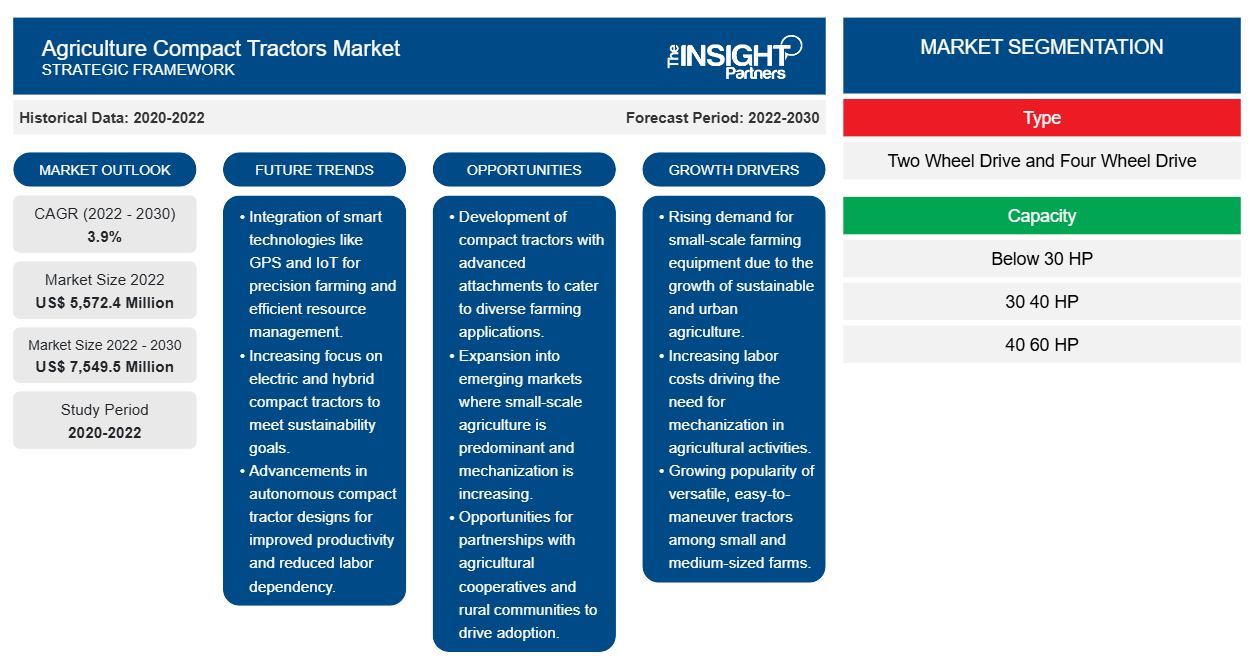[Forschungsbericht] Der Markt für Kompakttraktoren für die Landwirtschaft wird voraussichtlich von 5.572,4 Millionen US-Dollar im Jahr 2022 auf 7.549,5 Millionen US-Dollar im Jahr 2030 wachsen; der Markt wird voraussichtlich von 2022 bis 2030 eine durchschnittliche jährliche Wachstumsrate von 3,9 % verzeichnen.
Analystenperspektive:
Der kontinuierlich wachsende Agrarsektor und die zunehmende Vorliebe für moderne Geräte treiben das Wachstum des globalen Marktes für landwirtschaftliche Kompakttraktoren voran . Mit der kontinuierlich wachsenden Bevölkerung steigt auch die Nachfrage nach Nahrungsmitteln. Laut jüngsten Prognosen der Vereinten Nationen wird die Weltbevölkerung bis 2030 voraussichtlich 8,5 Milliarden erreichen und bis 2050 weiter auf 9,7 Milliarden anwachsen. Infolgedessen steigt die Nachfrage nach landwirtschaftlichen Produkten rapide an, was die Landwirte vor die Herausforderung stellt, die Erträge ihrer Betriebe zu steigern. Daher treibt der zunehmende Umfang der landwirtschaftlichen Aktivitäten die Nachfrage nach landwirtschaftlichen Kompakttraktoren an.
Im Januar 2024 stellte LS Mtron Co., ein südkoreanischer Hersteller von Schwermaschinen und elektronischen Komponenten, die neue Kleintraktorserie MT2·MT2E in Nordamerika vor. Die beiden Modelle dieser Serie – der Premium-MT2 und der preisgünstige MT2E – sind für einen besseren Bedienkomfort auf engstem Raum konzipiert und eignen sich für die Landwirtschaft im kleinen Maßstab. Diese Produktreihe wurde für verschiedene Aufgaben entwickelt, darunter ein einfach zu bedienender Shuttle für reibungslose Vorwärts- und Rückwärtsfahrten und Doppelpedale, die sich zum Transportieren von Erde oder Kies eignen. Solche Produktentwicklungsaktivitäten der Hersteller von landwirtschaftlichen Kompakttraktoren treiben das Wachstum des Marktes für landwirtschaftliche Kompakttraktoren voran.
Marktübersicht:
Kompakttraktoren, die normalerweise als kompakte Nutztraktoren bezeichnet werden, werden hauptsächlich für kleine landwirtschaftliche Tätigkeiten wie Pflügen, Mähen, Pflanzen, Bodenbearbeitung und Transportieren verwendet. Sie sind kleiner in Größe und Kapazität und eignen sich besser für kleine landwirtschaftliche Betriebe, Obst- und Nussplantagen, Weinberge, Gärten und Rasenflächen. Kompakttraktoren verbrauchen weniger Kraftstoff und haben einen geringen Wartungsbedarf, was zu niedrigen Betriebskosten führt.
Der asiatisch-pazifische Raum dominiert den Markt für landwirtschaftliche Kompakttraktoren aufgrund der umfangreichen landwirtschaftlichen Aktivitäten in Ländern wie China und Indien. Allerdings wird erwartet, dass Nordamerika und Europa im Prognosezeitraum starke CAGR-Werte verzeichnen werden. Die USA sind einer der größten Produzenten von Nüssen und Früchten. Laut den vom US-Landwirtschaftsministerium im Jahr 2022 veröffentlichten Daten machten kleine Familienbetriebe 88 % aller landwirtschaftlichen Betriebe in den USA aus. Daher ist die Präsenz einer großen Anzahl kleiner landwirtschaftlicher Betriebe in den USA ein Schlüsselfaktor, der dem Markt für landwirtschaftliche Kompakttraktoren in diesem Land zugute kommt.
Passen Sie diesen Bericht Ihren Anforderungen an
Sie erhalten kostenlos individuelle Anpassungen an jedem Bericht, einschließlich Teilen dieses Berichts oder einer Analyse auf Länderebene, eines Excel-Datenpakets sowie tolle Angebote und Rabatte für Start-ups und Universitäten.
-
Holen Sie sich die wichtigsten Markttrends aus diesem Bericht.Dieses KOSTENLOSE Beispiel umfasst eine Datenanalyse von Markttrends bis hin zu Schätzungen und Prognosen.
Markttreiber:
Regierungsinitiativen zur Unterstützung von Kleinbauern
Regierungspolitik und unterstützende Initiativen wie Finanzierungen erhöhen die Zahl der Kleinbauernhöfe in verschiedenen Ländern. So bietet das US-Landwirtschaftsministerium Kleinbauern und Jungbauern ein Mikrokreditprogramm an, das es ihnen ermöglicht, durch einfache Anträge Kredite in Höhe von bis zu 35.000 US-Dollar zu erhalten. Darüber hinaus kündigte die Regierung von Guyana im Jahr 2023 im Rahmen ihres Programms „National Pathway for Food Systems“ eine Initiative an. Im Rahmen dieses Projekts wurden Kleinbauern und Teilnehmern an laufenden sozioökonomischen Stärkungsprogrammen im ganzen Land Betriebsmittel und ein einmaliger Geldzuschuss bereitgestellt. Solche Regierungsinitiativen befähigen Kleinbauern, landwirtschaftliche Geräte, einschließlich Kompakttraktoren, einzusetzen. Darüber hinaus schaffen diese Programme und Initiativen ein förderliches Umfeld für Kleinbauernhöfe in Entwicklungs- und Industrieländern, was letztendlich zu einer Ausweitung des Marktes für landwirtschaftliche Kompakttraktoren führt.
Segmentanalyse:
Die Marktanalyse für landwirtschaftliche Kompakttraktoren wurde unter Berücksichtigung der folgenden Segmente durchgeführt: Typ, Kapazität und Anwendung. Auf der Grundlage der Kapazität ist der Markt in unter 30 PS, 30–40 PS und 40–60 PS segmentiert. Die Segmente 40–60 PS und 30–40 PS machen zusammen mehr als 50 % des Marktanteils landwirtschaftlicher Kompakttraktoren aus. Diese Traktoren eignen sich für mittelgroße landwirtschaftliche Betriebe für Aufgaben wie Pflügen, Bodenbearbeitung, Pflanzen und Ernten. So brachte Farmtrac beispielsweise 2024 seinen neuen Traktor Farmtrac 60 Powermaxx auf den Markt. Dieser Traktor hat einen 55-PS-Motor und bietet mehrere Funktionen.
Regionale Analyse:
Der geografische Umfang des Marktberichts für landwirtschaftliche Kompakttraktoren umfasst Nordamerika (USA, Kanada und Mexiko), Europa (Spanien, Großbritannien, Deutschland, Frankreich, Italien und das übrige Europa), den asiatisch-pazifischen Raum (Südkorea, China, Indien, Japan, Australien und den übrigen asiatisch-pazifischen Raum), den Nahen Osten und Afrika (Südafrika, Saudi-Arabien, Vereinigte Arabische Emirate und den übrigen Nahen Osten und Afrika) sowie Süd- und Mittelamerika (Brasilien, Argentinien und den übrigen Süd- und Mittelamerika). Der asiatisch-pazifische Raum hatte im Jahr 2022 den größten Marktanteil bei landwirtschaftlichen Kompakttraktoren.
Der nordamerikanische Markt für Kompakttraktoren für die Landwirtschaft ist in die USA, Kanada und Mexiko unterteilt. Der Agrarsektor in Nordamerika, insbesondere in Ländern wie den USA, Kanada und Mexiko, treibt die Nachfrage nach Kompakttraktoren für die Landwirtschaft maßgeblich an. Der Ausbau des Agrarsektors und kontinuierliche Produktentwicklungen werden den Markt in dieser Region auch in Zukunft weiter ankurbeln. Laut den vom US-Landwirtschaftsministerium im Jahr 2021 veröffentlichten Daten trug der Agrarsektor im Jahr 2021 etwa 1,264 Billionen US-Dollar zum US-BIP bei, was 5,4 % des nationalen BIP entspricht. Laut den von der kanadischen Regierung im Jahr 2022 veröffentlichten Daten leistet der Agrar- und Agrarlebensmittelsektor einen bedeutenden Beitrag zur kanadischen Wirtschaft. Die kanadischen Agrarrohstoffverkäufe, die jährlich um 5,6 % wachsen, beliefen sich im Jahr 2022 auf 87,7 Milliarden US-Dollar. Die steigende Zahl kleiner landwirtschaftlicher Betriebe führt zu einer größeren Nachfrage nach Kompakttraktoren, was den Anbietern neue Wachstumsmöglichkeiten bietet. Darüber hinaus konzentrieren sich viele wichtige Akteure in den Vereinigten Staaten derzeit auf die Entwicklung vollautomatischer Kompakttraktoren. Solche Entwicklungen dürften in den kommenden Jahren in Nordamerika zu neuen Trends auf dem Markt für Kompakttraktoren für die Landwirtschaft führen.
Regionale Einblicke in den Markt für landwirtschaftliche Kompakttraktoren
Die regionalen Trends und Faktoren, die den Markt für landwirtschaftliche Kompakttraktoren während des gesamten Prognosezeitraums beeinflussen, wurden von den Analysten von Insight Partners ausführlich erläutert. In diesem Abschnitt werden auch die Marktsegmente und die Geografie für landwirtschaftliche Kompakttraktoren in Nordamerika, Europa, im asiatisch-pazifischen Raum, im Nahen Osten und Afrika sowie in Süd- und Mittelamerika erörtert.

- Erhalten Sie regionale Daten zum Markt für landwirtschaftliche Kompakttraktoren
Umfang des Marktberichts für landwirtschaftliche Kompakttraktoren
| Berichtsattribut | Details |
|---|---|
| Marktgröße im Jahr 2022 | 5.572,4 Millionen US-Dollar |
| Marktgröße bis 2030 | 7.549,5 Millionen US-Dollar |
| Globale CAGR (2022 - 2030) | 3,9 % |
| Historische Daten | 2020-2022 |
| Prognosezeitraum | 2022–2030 |
| Abgedeckte Segmente |
Nach Typ
|
| Abgedeckte Regionen und Länder |
Nordamerika
|
| Marktführer und wichtige Unternehmensprofile |
|
Marktteilnehmerdichte für landwirtschaftliche Kompakttraktoren: Auswirkungen auf die Geschäftsdynamik verstehen
Der Markt für landwirtschaftliche Kompakttraktoren wächst rasant, angetrieben durch die steigende Endverbrauchernachfrage aufgrund von Faktoren wie sich entwickelnden Verbraucherpräferenzen, technologischen Fortschritten und einem größeren Bewusstsein für die Vorteile des Produkts. Mit steigender Nachfrage erweitern Unternehmen ihr Angebot, entwickeln Innovationen, um die Bedürfnisse der Verbraucher zu erfüllen, und nutzen neue Trends, was das Marktwachstum weiter ankurbelt.
Die Marktteilnehmerdichte bezieht sich auf die Verteilung der Firmen oder Unternehmen, die in einem bestimmten Markt oder einer bestimmten Branche tätig sind. Sie gibt an, wie viele Wettbewerber (Marktteilnehmer) in einem bestimmten Marktraum im Verhältnis zu seiner Größe oder seinem gesamten Marktwert präsent sind.
Die wichtigsten auf dem Markt für Kompakttraktoren für die Landwirtschaft tätigen Unternehmen sind:
- YANMAR Traktor
- Mahindra
- TYM CORPORATION
- Solectrac
- John Deere
Haftungsausschluss : Die oben aufgeführten Unternehmen sind nicht in einer bestimmten Reihenfolge aufgeführt.

- Überblick über die wichtigsten Akteure auf dem Markt für landwirtschaftliche Kompakttraktoren
Schlüsselspieleranalyse:
AGCO GmbH, Yamaha Tractors, Solis, Bobcat Company, Mahindra Tractors, Kubota, John Deere, Massey Ferguson und New Holland gehören zu den prominenten Akteuren, die im Marktbericht für landwirtschaftliche Kompakttraktoren vorgestellt werden. Zusätzlich zu diesen Akteuren wurden im Rahmen dieser Studie mehrere andere wichtige Unternehmen untersucht und analysiert, um einen ganzheitlichen Überblick über den globalen Markt für Nutz-Kompakttraktoren zu erhalten.
Aktuelle Entwicklungen:
Anorganische und organische Strategien wie Fusionen und Übernahmen werden von Unternehmen auf dem globalen Markt für landwirtschaftliche Kompakttraktoren häufig eingesetzt. Nachfolgend sind einige aktuelle Entwicklungen der wichtigsten Akteure auf dem Markt für landwirtschaftliche Kompakttraktoren aufgeführt, die in Pressemitteilungen veröffentlicht wurden:
Jahr |
Nachricht |
Region |
|
August 2023 |
Case IH hat seine neuen Farmall Subcompact 25SC-Traktoren vorgestellt. Dieses neu eingeführte Modell ist der kleinste Traktor im Portfolio von Case IH. Der neue Traktor verfügt über eine Motorleistung von 25 bis 115 PS. |
Asien & Pazifik |
|
Februar 2023 |
Bobcat hat eine neue Kompakttraktorreihe mit der Bezeichnung 1000, 2000 und 4000 eingeführt. Die Serie umfasst neun Kompakttraktormodelle, die sich anhand der Motorleistung unterscheiden. Diese Traktoren haben einen Leistungsbereich von 25 bis 85 PS. |
Europa |
- Historische Analyse (2 Jahre), Basisjahr, Prognose (7 Jahre) mit CAGR
- PEST- und SWOT-Analyse
- Marktgröße Wert/Volumen – Global, Regional, Land
- Branchen- und Wettbewerbslandschaft
- Excel-Datensatz
Aktuelle Berichte
Erfahrungsberichte
Grund zum Kauf
- Fundierte Entscheidungsfindung
- Marktdynamik verstehen
- Wettbewerbsanalyse
- Kundeneinblicke
- Marktprognosen
- Risikominimierung
- Strategische Planung
- Investitionsbegründung
- Identifizierung neuer Märkte
- Verbesserung von Marketingstrategien
- Steigerung der Betriebseffizienz
- Anpassung an regulatorische Trends























 Kostenlose Probe anfordern für - Markt für landwirtschaftliche Kompakttraktoren
Kostenlose Probe anfordern für - Markt für landwirtschaftliche Kompakttraktoren